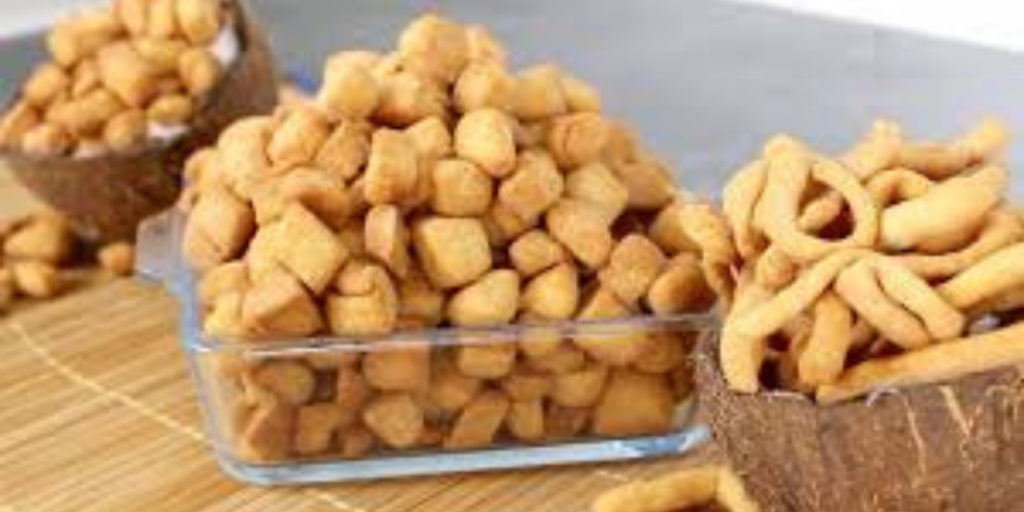Table of Contents

Before we embark on our culinary journey into making Nigerian Chin Chin, let’s take a moment to appreciate its cultural significance and popularity. Chin Chin is not just a snack; it’s a beloved treat across West Africa, enjoyed during festive occasions, family gatherings, and everyday snacking moments. Its crunchy texture and sweet flavor make it irresistible to both young and old alike.
The Ingredients Explained
Let’s start with understanding each ingredient’s role in creating the perfect Chin Chin:
- Flour: All-purpose flour forms the base of Chin Chin, providing structure and texture.
- Sugar: Granulated sugar adds sweetness and aids in achieving a golden brown color when fried.
- Butter: Butter (or margarine) contributes to the richness and flavor of Chin Chin, as well as its crispy texture.
- Eggs: Eggs act as a binder, helping to bring the dough together and providing some richness.
- Baking Powder: Baking powder helps Chin Chin puff slightly during frying, contributing to its airy texture.
- Salt: Salt enhances the overall flavor profile, balancing the sweetness of the sugar.
- Ground Nutmeg: Optional, but traditional, ground nutmeg adds a warm, aromatic flavor to Chin Chin.
- Vegetable Oil: Used for frying, vegetable oil should be neutral-tasting and have a high smoke point.
Equipment Needed
Before we begin, let’s ensure we have all the necessary equipment ready:
- Large Mixing Bowl: For combining ingredients and kneading the dough.
- Rolling Pin: To roll out the dough to an even thickness.
- Knife or Pizza Cutter: For cutting the Chin into desired shapes.
- Deep Fryer or Large Pan: For frying the Chin Chin pieces.
- Slotted Spoon or Spider Strainer: To remove Chin Chin from the hot oil.
- Paper Towels or Wire Rack: For draining excess oil from the fried Chin Chin.
What can I use to preserve chin chin? Nigerian Best no 1
Now that we’re well-prepared, let’s dive into the step-by-step process of making with 500g of flour.
Step-by-Step Guide

Step 1: Prepare Your Ingredients
Gather all your ingredients and measure them accurately. This preparation step ensures a smooth cooking process and helps maintain consistency in your Chin.
Step 2: Combine the Dry Ingredients
In a large mixing bowl, sift together the flour, baking powder, salt, and ground nutmeg (if using). Sifting the dry ingredients ensures they are well mixed and aerated, which contributes to a lighter Chin texture.
Step 3: Incorporate the Butter
Cut the butter (or margarine) into small cubes and add them to the bowl with the dry ingredients. Using your fingertips or a pastry cutter, rub the butter into the flour mixture until it resembles coarse breadcrumbs. This step is crucial as it evenly distributes the fat throughout the dough, resulting in a tender and flaky Chin.
Step 4: Add the Sugar
Next, add the granulated sugar to the flour and butter mixture. Mix well to ensure the sugar is evenly distributed. The sugar not only sweetens the Chin but also aids in achieving a crispy exterior when fried.
Step 5: Beat the Eggs
In a separate bowl, lightly beat the eggs until they are well combined. Create a well in the center of the flour mixture and pour the beaten eggs into it.
Step 6: Mix and Knead the Dough
Using a wooden spoon or your hands, gradually incorporate the flour mixture into the eggs. Mix until a rough dough forms. If the dough feels dry, add milk or water, a tablespoon at a time, until the dough comes together without being sticky.
Step 7: Rest the Dough
Once the dough is formed, wrap it in plastic wrap or cover it with a clean kitchen towel. Allow it to rest at room temperature for about 30 minutes. This resting period allows the gluten to relax, making the dough easier to roll out and resulting in a lighter Chin.
Step 8: Roll Out the Dough
After resting, divide the dough into smaller portions for easier handling. On a lightly floured surface, roll out each portion of dough into a thin sheet, about 1/4 inch thick. The thickness of the dough will affect the final texture – thinner dough will yield crispier Chin Chin, while thicker dough will be more substantial.
Step 9: Cut Into Shapes
Using a sharp knife, pizza cutter, or cookie cutters, cut the rolled-out dough into desired shapes. Traditional shapes are often rectangular or diamond-shaped, but feel free to get creative with shapes and sizes.
Step 10: Heat the Oil
In a deep fryer or large, heavy-bottomed pan, heat vegetable oil over medium-high heat until it reaches 350°F (175°C). It’s essential to maintain a consistent oil temperature throughout frying to ensure even cooking and crispy .
Step 11: Fry the Chin Chin
Carefully drop a few pieces into the hot oil, being cautious not to overcrowd the pan. Fry in batches, stirring occasionally with a slotted spoon or spider strainer, until the Chin Chin are golden brown and crispy, about 3-5 minutes per batch.
Step 12: Drain and Cool
Once fried, use a slotted spoon or spider strainer to transfer the Chin Chin to a plate lined with paper towels. This allows excess oil to drain off and ensures a lighter, less greasy snack. Alternatively, you can place them on a wire rack to cool.
Step 13: Enjoy Your Homemade Chin Chin!
Your homemade Nigerian Chin Chin is now ready to be enjoyed! Allow them to cool completely before serving. Chin Chin can be enjoyed on its own as a delightful snack or paired with hot beverages like tea or coffee.
Troubleshooting Tips

- Dough Too Dry: If your dough is too dry and crumbly, add a little more milk or water until it reaches a smooth consistency.
- Dough Too Sticky: If your dough is too sticky, sprinkle a little flour on your hands and work surface while kneading.
- Not Crispy: Ensure the oil is at the correct temperature (around 350°F/175°C) and fry in small batches to maintain consistent heat.
- Too Dark: Adjust the frying time if your Chin Chin are browning too quickly. Lower the heat slightly and monitor closely.
Variations and Flavor Enhancements
While traditional is delightful on its own, you can experiment with different flavors and additions:
- Vanilla Extract: Add a teaspoon of vanilla extract to the dough for a fragrant twist.
- Citrus Zest: Incorporate finely grated lemon or orange zest for a refreshing citrus flavor.
- Cinnamon: Substitute ground nutmeg with ground cinnamon for a spiced Chin Chin variation.
- Sesame Seeds: Sprinkle sesame seeds on the dough before frying for added crunch and nuttiness.
- Coconut: Add desiccated coconut to the dough for a tropical twist.
Storage and Shelf Life

Store leftovers in an airtight container at room temperature for up to two weeks. Ensure they are fully cooled before storing to maintain crispiness. Chin Chin can also be frozen for longer storage. Simply thaw at room temperature before serving.
Conclusion
Congratulations on mastering the art of making Nigerian Chin Chin! We hope this detailed guide has not only provided you with a delicious recipe but also inspired you to explore the rich culinary traditions of West Africa. Whether you’re making Chin Chin for a special occasion or simply to enjoy with loved ones, the process of creating homemade snacks is always rewarding.
If you’ve enjoyed this guide, please share it with friends and family who might also appreciate making Chin Chin at home. Your feedback is valuable to us, so feel free to leave a comment below with your thoughts or any questions you may have. Happy cooking!
Additional Notes and Cultural Insights
History and Significance of Chin Chin
Chin Chin has deep roots in West African culinary traditions and is often associated with celebrations, festivals, and gatherings. Its origins can be traced back to various regions across West Africa, where it has evolved over generations into the beloved snack we know today. The name “Chin Chin” itself is believed to have been derived from the Chinese term for fried dough snacks, reflecting the multicultural influences present in African cuisine.
Regional Variations
While the basic ingredients and preparation methods for Chin Chin remain consistent, there are regional variations that reflect local tastes and preferences. In Nigeria, for example, Chin Chin recipes can vary from one household to another, with some adding spices like cloves or cardamom for additional flavor complexity. In Ghana, Chin Chin is sometimes made with additional ingredients such as peanuts or dried fruits, offering a unique twist on this classic snack.
Cultural Significance
Beyond its culinary appeal, Chin Chin holds cultural significance in West African communities. It is often served during traditional ceremonies, such as weddings, birthdays, and religious festivities, symbolizing abundance, hospitality, and togetherness. Sharing Chin Chin with guests is a gesture of warmth and hospitality, embodying the spirit of community and celebration.
Nutritional Information
While Chin Chin is undeniably delicious, it is essential to enjoy it in moderation as part of a balanced diet. Like many fried snacks, Chin Chin is calorie-dense and high in carbohydrates and fats. For those with dietary restrictions or preferences, there are healthier variations that use whole wheat flour or incorporate alternative sweeteners like honey or agave syrup.
Social Media and Community Engagement
We encourage you to share your Chin Chin-making experience on social media! Tag us in your photos and videos, and don’t forget to use the hashtag #ChinChinDelight to connect with others who share your love for this iconic West African snack. Your creativity and passion for cooking are what make culinary traditions like Chin Chin thrive and evolve over time.
Final Thoughts
Thank you for joining us on this culinary adventure into the world of Nigerian Chin Chin. Whether you’re a novice cook or a seasoned chef, we hope this guide has inspired you to try your hand at making Chin Chin at home. Remember, the key to perfect Chin Chin lies in patience, attention to detail, and a sprinkle of creativity. Happy cooking and enjoy your homemade Chin Chin!






















Hi there friends, fastidious post and pleasant urging commented at this place, I am in fact enjoying by these.
Feel free to surf to my page … Fryd Dirty Stripe Strain For Sale